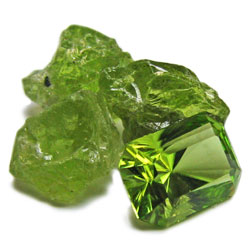

Comprised of the mineral olivine, peridot is the only gemstone this mineral produces. Peridot is also doubly refractive, when light enters the crystal it splits up into two separate rays. This phenomenon can be seen in the photo above. Though generally found in volcanic rocks called basalts, peridot can be found in more exotic locations such as Peridot Beach in Hawaii, where olivine is so abundant the sands are actually green. Peridot can also, very rarely, be found in nickel-iron and olivine meteorites that have fallen to earth.
| Chemical Formula | (Mg,Fe)2SiO4 | Mineral Class | Olivine |
|---|---|---|---|
| Color | Green | ||
| Crystal System | Orthorhombic | Hardness | 6.5-7 |
| Transparency | Transparent | Luster | Vitreous |
| Refractory Index | 1.65 - 1.69 | Double Refraction | 0.035 - 0.038 |
Legend has it that the island Zabargad, where peridot was mined around 340–279 BCE, was infested with snakes, earning the island names like "Island of Death" and "Ophiodes" (snake island). It was believed an enterprising pharaoh drove the snakes into the sea.
Believing it protected its wearer from terrors of the night, ancient Egyptians called peridot the “Gem of the Sun”.
Peridot has been used for centuries as a protective talisman, shielding the owner from evil spirits and terrors of the night.
Peridot was also believed to ensure peace and happiness.
In Hawaii peridot symbolizes the tears of Pele, the volcano goddess of fire who controls the flow of lava.
Egyptian priests believed that peridot harnessed the power of nature and used goblets encrusted with it to commune with their nature gods.